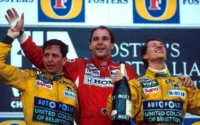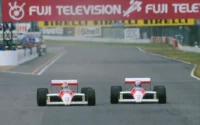March Engineering was a F1 constructor and manufacturer of customer racing cars from the United Kingdom. While their success in F1 was moderate, March racing cars achieved significant success in other categories, including Formula Two, Formula Three, IndyCar, and IMSA GTP sportscar racing.
Notable Team Members and Drivers
Founders: March Engineering began operations in 1969, founded by Max Mosley, Alan Rees, Graham Coaker, and Robin Herd. The company name is an acronym of their initials. Each founder had a specific area of expertise: Mosley managed the commercial side, Rees oversaw the racing team, Coaker handled production at the Bicester, Oxfordshire factory, and Herd was the designer.
Adrian Newey: Renowned for his innovative designs, Newey joined March F1 in 1987 and designed the March-Judd 881. The 881’s aerodynamics and ultra-slim monocoque were groundbreaking and influenced many 1989 Formula One cars.
Background
Founded in 1969, March Engineering began racing in 1970. In 1977, the team’s assets and FOCA membership were sold to ATS. An ill-fated return to Formula One in 1981 lasted only two years. The team then focused on racing across the Atlantic before starting a new F1 project in 1987 with Leyton House. By mid-1989, Leyton House had fully taken over the team, but it was sold back for the 1992 season. However, financial difficulties led to the team’s collapse, and despite an entry to the 1993 South African Grand Prix, March Engineering’s Formula One team ended.
1970s
March’s history is marked by balancing the demands of Formula One development with building reliable customer cars for profit. Herd initially planned to build a single-car F1 team around Jochen Rindt, but Rindt chose to stay with Team Lotus due to the size of the March program.
March’s launch was notable for its ambition. After building a single Formula Three car in 1969, March announced plans to produce customer cars for F1, F2, F3, Formula Ford, and Can-Am in 1970, along with running works teams in these categories.
March’s Formula One efforts began promisingly, supplying Tyrrell with the 701 chassis for Jackie Stewart. The factory team ran cars for Jo Siffert and Chris Amon, with additional entries for Mario Andretti and Ronnie Peterson. Stewart won the 1970 Spanish Grand Prix in a March, and the team achieved other notable finishes, but the works team did not win a championship race.
In 1971, March introduced the innovative 711 chassis with its distinctive “tea-tray” front wing. Though the car didn’t win any races, Peterson finished second in the World Championship. The following season saw the introduction of the 721, which struggled with performance issues, leading to the development of the 721G from the F2 chassis.
March’s fortunes in Formula One declined in 1973. The team, now without significant STP sponsorship, struggled, with their best result being a seventh-place finish. The focus shifted more towards Formula Two, where they achieved considerable success with BMW engines.
In 1974, March ran Hans-Joachim Stuck and Vittorio Brambilla in F1, but accidents and pressure from BMW to concentrate on F2 hindered their progress. In 1975, Brambilla won the Austrian Grand Prix, and Lella Lombardi scored a point in Spain, marking the first time a woman scored in F1. March also provided cars for privateers, including a notable chassis for Frank Williams.
The 1976 season saw Ronnie Peterson return to March, scoring their second and final F1 win at Monza. Financial constraints and BMW’s focus on F2 limited their F1 program, leading to a scaled-back effort with Peterson and Brambilla.
In 1977, March engineer Wayne Eckersley developed the unique four-wheel-drive 2-4-0 chassis, which showed promise but was ultimately not pursued. The F1 effort continued with Rothmans sponsorship but yielded little success. Privateers continued to use March cars, including a modified 761 by Arturo Merzario.
At the end of 1977, March’s F1 assets were sold to ATS, and Mosley left the company. March then focused on Formula Two, where they achieved dominance with the 782 chassis and drivers like Bruno Giacomelli.
By 1978, March concentrated on Formula Two, with occasional entries in minor F1 series and assisting in the production of BMW M1 racing cars. The 782 chassis became dominant in F2, and March regained its prominence in the category, with Marc Surer winning the F2 title in 1979
1980s
In 1981, March Engineering made a half-hearted and poorly financed attempt to return to Formula One. They built cars that were essentially heavy and insufficiently stiff copies of the Williams FW07 for Mick Ralph and John McDonald’s RAM Racing. Initially driven by Eliseo Salazar, he was soon replaced by Derek Daly. Despite securing a major sponsorship deal from Rothmans in 1982, the funds arrived too late for Robin Herd or Adrian Reynard (the chief engineer) to significantly improve the cars’ performance. By 1983, McDonald started building his own cars, and March was left out of Formula One once more. During this phase, March Engines, a separate entity within the group, undertook various bespoke customer projects, including a highly modified BMW M1 and the unsuccessful Orbitor Indycar based on the 792 chassis.
In the early 1980s, March focused primarily on Formula Two and breaking into the Indy car market. Ironically, while their FW07 copy failed in Formula One, it was successful when developed into the 81C Indycar, thanks largely to George Bignotti’s involvement. Cosworth-powered Marches won the Indianapolis 500 five consecutive times from 1983 to 1987, with the March 86C winning twice in a row in 1986 and 1987. Conversely, when Williams licensed the FW07 design to Bobby Hillin, the resulting Longhorn cars were a failure.
March also built a line of sports prototypes descended from the unsuccessful BMW M1C, which enjoyed considerable success in America with Porsche or Chevrolet engines, including a victory in the 1984 24 Hours of Daytona. However, a works BMW deal in IMSA was less successful due to engine problems, although the cars were intermittently very fast.
In 1982, Corrado Fabi won March’s last Formula Two title as the formula became increasingly dominated by Ralt-Hondas. March exited the Formula Three market at the end of 1981, having previously enjoyed periods of dominance. The new Formula 3000 in 1985 brought success for March, with Christian Danner, Ivan Capelli, and Stefano Modena winning the championship in March chassis from 1985 to 1987. Meanwhile, March dominated Indycar racing, with 30 out of 33 starters in the Indianapolis 500 being Marches at one point.
In 1987, March launched a new Formula One program with the Ford-engined 871, sponsored by Leyton House and driven by Ivan Capelli. In August 1987, Adrian Newey joined March F1, designing the March-Judd 881, which scored 22 points in 1988, including a second-place finish at the 1988 Portuguese Grand Prix. Capelli briefly led the 1988 Japanese Grand Prix, marking the first time a normally aspirated car had led a Grand Prix since 1983. The 881’s aerodynamics and ultra-slim monocoque influenced many 1989 F1 cars and established Newey as a top designer.
In April 1987, March went public, initially valued at £14.5 million. However, financial struggles in America and the unfavourable exchange rate led to the company’s decline. In early 1989, Akira Akagi’s Leyton House bought March Racing, including the F1 operation and F3000 production facilities, allowing Herd to pursue other ventures.
1990s
March Engineering focused on high-value partnership deals, such as collaborations with Porsche and Alfa Romeo for Indycar projects. While the Porsche deal led to some success, the Alfa Romeo project was unsuccessful. The company also engaged in consultancy work on the Panther Solo supercar and expanded its composites and wind tunnel businesses. However, the wind tunnel proved problematic, as its overly efficient insulation turned it into a pressure cooker, producing unreliable results that hampered the competitiveness of several teams, including Lotus. The economic downturn of the late 1980s severely impacted March’s market. Recognising the need to improve their customer cars, March decided to merge with Ralt. March would handle industry partnerships, while Ralt focused on production categories. Despite this merger, the businesses were never efficiently integrated.
Leyton House Racing
The Formula One team raced as Leyton House Racing in 1990 and 1991, using Ilmor V10 engines. They nearly caused a significant upset at the 1990 French Grand Prix, where Capelli and Gugelmin, benefiting from superior aerodynamics and a smooth race track, attempted to complete the race on a single set of tyres while other teams made mid-race tyre changes. Engine problems ultimately forced Gugelmin to retire and slowed Capelli, allowing Alain Prost to overtake him with three laps remaining. By the end of 1991, Akira Akagi was embroiled in the Fuji Bank scandal, leading to Leyton House’s withdrawal from racing. The team was bought by Ken Marrable, an associate of Akagi, and resumed the March name for the 1992 season. However, with limited funding, the results were disappointing. The Leyton House Racing operation shut down as the team, now unconnected to the March group, attempted to launch a new project for the 1993 season.
March Engineering Formula One World Championship Records
| First entry | 1970 South African Grand Prix |
|---|---|
| Races entered | 205 (195 starts) |
| Engines | Ford, Alfa Romeo, Judd, Ilmor |
| Constructors’ Championships | 0 |
| Drivers’ Championships | 0 |
| Race victories | 2 |
| Pole positions | 2 |
| Fastest laps | 4 |
| Final entry | 1992 Australian Grand Prix |
Entrant Names
| Years | Name |
|---|---|
| 1970 | March Engineering |
| 1971 – 1973 | STP March Racing Team |
| 1974 | March Engineering |
| 1975 – 1976 | Beta Team March |
| 1975 – 1976 | Lavazza March |
| 1976 | March Engineering |
| 1976 | Ovoro Team March |
| 1977 | Hollywood March Racing |
| 1977 | Team Rothmans International |
| 1981 – 1982 | March Grand Prix Team |
| 1982 | Rothmans March Grand Prix Team |
| 1987 – 1989 | Leyton House March Racing Team |
| 1992 – 1993 | March F1 |
March Engineering Constructors’ Championship Results
| Year | Car | Engine | Tyre | No. | Drivers | Rounds | WCC Points1 | WCC Pos. | Report |
|---|---|---|---|---|---|---|---|---|---|
| 1970 | 701 | Ford Cosworth | F | Chris Amon Jo Siffert | All All | 48 | 3rd | ||
| 1971 | 711 | Ford Cosworth Alfa Romeo | F | Andrea de Adamich Ronnie Peterson Alex Soler-Roig Nanni Galli Niki Lauda Mike Beuttler | 1–2, 5–8, 10, 12 All 1–5 3–11 8 10 | 33 (34) 0 | 4th NC | ||
| 1972 | 721 721X 721G | Ford Cosworth | G | Ronnie Peterson Niki Lauda | All All | 15 | 6th | ||
| 1973 | 721G 731 | Ford Cosworth | G | Jean-Pierre Jarier Herni Pescarolo Roger Williamson | 1–3, 5–8, 11–15 4 9–10 | 14 | 5th | ||
| 1974 | 741 | Ford Cosworth | G | 9 9 10 10 | Hans-Joachim Stuck Reine Wisell Howden Ganley Vittorio Brambilla | 1–6, 8–15 7 1–2 3–15 | 6 | 9th | |
| 1975 | 741 751 | Ford Cosworth | G | 9 10/29 10 | Vittorio Brambilla Lella Lombardi Hans-Joachim Stuck | All 3–13 10–14 | 7.5 | 8th | |
| 1976 | 761 | Ford Cosworth | G | 9 10 10 34 35 | Vittorio Brambilla Lella Lombardi Ronnie Peterson Hans-Joachim Stuck Arturo Merzario | All 1 2–16 All 3–9 | 19 | 7th | |
| 1977 | 761B 771 | Ford Cosworth | G | 9 10 10 10 | Alex Ribeiro Ian Scheckter Hans-Joachim Stuck Brian Henton | All 1–2, 5–17 3 4 | 0 | NC | |
| 1978 | Private entries only | 0 | NC | ||||||
| 1981 | 811 | Ford Cosworth | M A | 17/18 17/18 18 | Derek Daly Eliseo Salazar Stefan Johansson | All 1–6 9 | 0 | NC | |
| 1982 | 821 | Ford Cosworth | P A | 17 17 18 19 | Jochen Mass Rupert Keegan Raul Boesel Emilio de Villota | 1–3, 5–11 12–16 1–3, 5–16 5–9 | 0 | NC | |
| 1987 | 87P 871 | Ford Cosworth | G | 16 | Ivan Capelli | All | 1 | 13th | |
| 1988 | 881 | Judd | G | 15 16 | Maurício Gugelmin Ivan Capelli | All All | 22 | 6th | |
| 1989 | 881 CG891 | Judd | G | 15 16 | Maurício Gugelmin Ivan Capelli | All All | 4 | 12th | |
| 1992 | CG911 | Ilmor | G | 16 16 17 17 | Karl Wendlinger Jan Lammers Paul Belmondo Emanuele Naspetti | 1–14 15–16 1–11 12–16 | 3 | 9th | |
| 1993 | CG911C | Ilmor | G | 16 17 | Jean-Marc Gounon Jan Lammers | 1 1 | 0 | NC | † |
1Points include those scored by private entries.
† March did not compete in any races but entered the season opener in South Africa.
Private Entrants
| Year | Entrant | Car | Engine | Tyre | No. | Drivers | Rounds* |
|---|---|---|---|---|---|---|---|
| 1970 | Tyrrell Racing Organisation | 701 | Ford Cosworth | D | Jackie Stewart Johnny Servoz-Gavin François Cevert | 1–10 1–3 5–13 | |
| STP Corporation | 701 | Ford Cosworth | F | Mario Andretti | 1–5, 7–9 | ||
| Antique Automobiles Racing Team Colin Crabbe Racing | 701 | Ford Cosworth | G | Ronnie Peterson | 3–8, 10–12 | ||
| Hubert Hahne | 701 | Ford Cosworth | F | Hubert Hahne | 8 | ||
| 1971 | Frank Williams Racing Cars | 701 711 | Ford Cosworth | F | Henri Pescarolo Derek Bell Max Jean Carlos Pace | All 2–3 5 9 | |
| Team Gunston | 701 | Ford Cosworth | G | John Love | 1 | ||
| Gene Mason Racing | 711 | Ford Cosworth | F | Skip Barber | 3–4, 10–11 | ||
| Jo Siffert Automobiles | 701 | Ford Cosworth | F | François Mazet | 5, 9 | ||
| Clarke-Mordaunt-Guthrie Racing | 701 711 | Ford Cosworth | F | Mike Beuttler | 2–3, 5, 6–9 | ||
| Shell Arnold Team | 701 | Ford Cosworth | F | Jean-Pierre Jarier | 5, 9 | ||
| 1972 | Team Williams Motul | 711 721 | Ford Cosworth | G | Henri Pescarolo Carlos Pace | 1–6, 8–12 2–12 | |
| Clarke-Mordaunt-Guthrie Racing | 721G | Ford Cosworth | F | Mike Beuttler | 3–12 | ||
| Speed International | 711 | Ford Cosworth | G | Ray Allen | 7 | ||
| Gene Mason Racing | 711 | Ford Cosworth | F | Skip Barber | 11–12 | ||
| 1973 | Clarke-Mordaunt-Guthrie Racing | 721G 731 | Ford Cosworth | F G | Mike Beuttler Reine Wisell | 1–7, 9–15 7–8 | |
| LEC Refrigeration Racing | 731 | Ford Cosworth | G | David Purley | 6, 8–11, 13 | ||
| Hesketh Racing | 731 | Ford Cosworth | G | James Hunt | 6, 8–12, 14–15 | ||
| 1974 | Hesketh Racing | 731 | Ford Cosworth | F | 24 | James Hunt | 1–2 |
| Dempster International Racing Team | 731 | Ford Cosworth | F | 35 | Mike Wilds | 10 | |
| 1975 | Penske Cars | 751 | Ford Cosworth | G | 28 | Mark Donohue | 10–12 |
| 1976 | Sports Cars of Austria | 761 | Ford Cosworth | G | 40 | Karl Oppitzhauser | 11 |
| 1977 | Williams Grand Prix Engineering | 761 | Ford Cosworth | G | 27 | Patrick Nève | 5, 7–16 |
| Chesterfield Racing | 761 | Ford Cosworth | G | 30 | Brett Lunger | 3–5 | |
| RAM Racing/F&S Properties RAM Racing | 761 | Ford Cosworth | G | 32/39 32 32/33 33 | Mikko Kozarowitsky Michael Bleekemolen Boy Hayje Andy Sutcliffe | 5, 7–8, 10–11 13 3, 5–8, 12–13 10 | |
| Team Merzario | 761B | Ford Cosworth | G | 37 | Arturo Merzario | 5–11, 13–14 | |
| British Formula One Team | 761 761B | Ford Cosworth | G | 38 38 38/46 38 | Brian Henton Jean-Pierre Jabouille Bernard de Dryver Henri Pescarolo | 5, 10, 12 6 7, 10 9 | |
| 1978 | Patrick Nève | 781S | Ford Cosworth | G | 29 | Patrick Nève | 6 |
*Refers to rounds driven in March cars.
Source: Wikipedia.com and fandom.com


